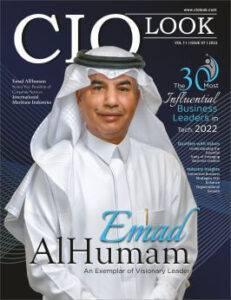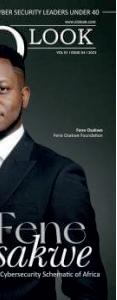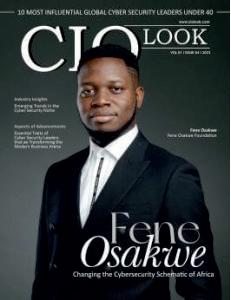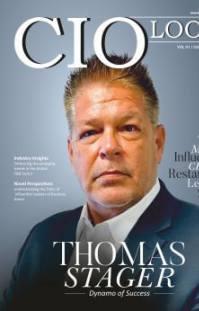Editor’s Note
18
A R T I C L E S
From Knowledge to Ac�on
Transforming Educa�on with Modern Learning Techniques
From Vision to Reality
Transforming Educa�on Through Learning Innova�on
PoojaMBansal Editor-in-Chief
CONTENT
Deputy Editor Anish Miller
Managing Editor Prince Bolton
DESIGN
Visualizer Dave Bates
Art & Design Director Davis Mar�n
Associate Designer Jameson Carl
SALES
Senior Sales Manager Wilson T., Hunter D.
Customer Success Manager Nelson M.
Sales Execu�ves Tim, Smith
TECHNICAL
Technical Head Peter Hayden
Technical Consultant Victor Collins July,
Research Analyst Eric Smith
SEO Execu�ve Alen Spencer
FOLLOWUSON
www facebook.com/ciolookmedia/ www.x.com/ciolookMedia
www.linkedin.com/company/ciolook
WE ARE ALSO AVAILABLE ON
CONTACTUSON
Email info@ciolook com
For Subscrip�on www.ciolookmedia.com
Copyright © 2025 CIOLOOK, All rights reserved. The content and images used in this magazine should not be reproduced or transmi�ed in any form or by any means, electronic, mechanical, photocopying, recording or otherwise, without prior permission from CIOLOOK. Reprint rights remain solely with CIOLOOK.
Few individuals leave behind a legacy that transcends academic disciplines and resonates across generations.RichardLarsonisonesuchexceptional figure As a Professor at the Massachusetts Institute of Technology (MIT), Larson has devoted over five decades to learning,teaching,andmentoring.Hisjourneyisatestament to a life fueled by curiosity, a deep sense of purpose, and an unwavering commitment to the advancement of knowledge. Larson exemplifies the archetype of a lifelong learner, educator, and mentor whose influence continues to ripple acrossglobalacademicandprofessionalcommunities.
RichardLarson'sprofessionaltrajectoryreflectsaconfluence of perseverance, intellectual agility, and an interdisciplinary vision. His work has constantly challenged traditional academicboundaries,integratingsystemsthinkingwithrealworldproblem-solving.Whetherthroughhisleadershiproles in operations research or his pioneering contributions to global education initiatives, Larson has consistently demonstrated a rare blend of academic rigor and humancentric values. He believes that education is not merely a meanstoanendbutacatalystforsocietaltransformationand collectiveprogress.
Richard Larson’s career encapsulates the power of education, mentorship, and innovation to drive global progress
This profile explores Larson’s journey through various academic departments, his practical consulting work, leadership in professional organizations, and his forwardthinking use of technology to democratize education. By examining the philosophies and principles that have guided hislife,wediscoveraninspiringmodelforaspiringleaders, educators,andchange-makers.Hisstoryinvitesreflectionon howintellectualcuriosity,compassion,andpurposefulaction cancollectivelyshapeaworldthatvaluesbothknowledgeand humanity.
LeadingwithaLifelongLearningMindset
According to Richard Larson, exceptional individuals who make significant contributions are often defined by their resolute commitment to lifelong learning and mentorship. These people—educators, researchers, innovators—embody core values like perseverance, adaptability, and continuous growth.Theirpassionforexplorationandtheirwillingnessto challenge the status quo elevate them to positions of global influence.
Larsonviewssuchindividualsnotasisolatedgeniusesbutas members of a broader intellectual ecosystem. They foster environments where learning is a shared pursuit and where mentoring becomes a way to multiply impact. To him, the measure of true leadership lies not in accolades, but in how effectivelyonenurturesthepotentialinothersandencourages interdisciplinary dialogue that addresses complex global challenges.
By integrating curiosity with courage, Larson notes, these leaders transform the educational experience from a transactional model into a transformational journey. They leavebehindlegaciesthatinspirefuturegenerationstothink critically,actethically,andleadwithintegrity
BridgingDisciplinesforGlobalSolutions
Throughout his distinguished career, Larson has witnessed how interdisciplinary collaboration opens doors to new discoveries and transformative change. He recalls how his own academic path led him from electrical engineering to urban studies, civil engineering, and eventually to the interdisciplinaryMITInstituteforData,SystemsandSociety (IDSS) This journey mirrors his belief that the most innovative solutions often arise when diverse disciplines intersect.
ForLarson,dataandsocietalneedsmustbedeeplyintegrated inresearchandteaching.HeseesIDSSasamanifestationof this ideal an academic hub that synthesizes technical precision with social relevance. Whether the goal is to optimizeurbaninfrastructure,managehealthcaresystems,or address climate change, Larson believes that bridging engineeringwithsocialscienceoffersthebestpathforward.
He underscores that true educational leadership lies in not onlyaskingdifficultquestionsbutalsocreatingspaceswhere those questions can be explored through diverse lenses. For him, education is at its most powerful when it transcends disciplinary silos and fosters collaboration among thinkers fromdifferentbackgrounds.
EmpoweringFutureLeadersThroughMentorship
Larson emphasizes that teaching is not just a transfer of information—itisthecultivationofinsightandself-beliefin students.Themostfulfillingmomentsinhiscareer,heshares, havebeenthosewhenastudentexperiencesabreakthroughor finds a new path through learning. These moments, to him, reaffirmthevalueofmentorshipasalong-terminvestmentin thefuture.
As a mentor, Larson seeks to empower rather than instruct. His teaching philosophy is grounded in mutual respect, critical thinking, and real-world application. Whether in a classroom or a research lab, he approaches each student interactionasanopportunitytolisten,guide,andinspire.He takes pride in watching his students become leaders in their ownright,carryingforwardtheprinciplesheholdsdear.
Through programs like MIT BLOSSOMS, Larson has extended his mentorship beyond institutional boundaries, providing open educational resources to students around the world. These efforts reflect his belief that mentorship is not boundbyproximityorposition—itisaglobalresponsibility
Richard Larson's professional trajectory re�ects a con�uence of perseverance, intellectual agility, and an interdisciplinary vision.
LeadingfromtheFrontinResearchandAcademia
Larsonhasheldpivotalleadershippositionsthatreflectboth trust in his capabilities and his commitment to collective progress. At MIT, he has served as Co-Director of the Operations Research Center and Director of the Center for AdvancedEngineeringStudies.Theseroleshaveallowedhim to champion academic innovation and institutional growth simultaneously.
Beyond MIT, Larson's leadership in organizations like the Operations Research Society of America (ORSA) and the InstituteforOperationsResearchandtheManagement
Sciences(INFORMS)hashadatransformativeimpactonthe field. He does not view these leadership responsibilities as separate from his research; instead, he sees them as amplifyinghisabilitytoaffectmeaningfulchange.
Hisapproachtoleadershipisbothprincipledandpragmatic. Larson advocates for team environments that balance high expectations with mutual respect He believes in open communication, objective evaluation, and shared accountability principles that cultivate not only high performancebutalsopsychologicalsafety
ApplyingTheoryThroughPracticalConsulting
One of the unique aspects of Larson’s career is the seamless integration of theory with practice. Through his consulting work with the Institute for DefenseAnalyses (IDA), RAND Corporation, and his own firm, ENFORTH Corporation, he hasbroughtacademicinsightsintotherealmofpublicpolicy, defense,andbusiness.
Larson finds that hands-on consulting experiences not only enhance his research but also enrich his teaching. He often incorporates real-world scenarios into his lectures, helping students understand the practical relevance of complex theories.Thisconnectionbetweenacademiaandapplication helpshisstudentsseethebroaderimplicationsoftheirstudies.
He believes that scholars have a duty to ensure that their researchaddressesrealsocietalneeds.Consultingallowshim to remain grounded, maintain relevance, and stay informed abouttheevolvingchallengesfacingglobalsystems.
DemocratizingEducationwithTechnology
Larson has always been ahead of the curve in embracing technology as a tool for educational equity He recalls the transition from typewriters to the digital age and marvels at how the internet has become a gateway to learning for millions. He celebrates the accessibility and openness that technologynowoffers,particularlytolearnersinunderserved regions.
His work on the MITBLOSSOMS initiative stands out as a pioneering example By creating high-quality, freely available video lessons in STEM subjects, Larson and his team have reached students across continents. He takes particular pride in the program’s ability to offer interactive, engagingcontentthatmakescomplextopicsaccessible.
Looking ahead, Larson sees Artificial Intelligence as a powerful agent of transformation in education. While cautiousaboutitsethicalimplications,heisoptimisticabout AI’spotentialtopersonalizelearning,supporteducators,and makeknowledgemoreactionable.
BuildingPurpose-DrivenTeams
In both academic and consulting environments, Larson has consistentlyprioritizedteamcohesionandequity.Hebelieves thatsuccessfulcollaborationdependsonrespect,honesty,and shared goals. Every team member, regardless of rank or background, deserves a voice and a clear understanding of expectations.
Larson's communication style is rooted in directness and empathy He encourages feedback, transparency, and consistentevaluationprocesses.Metrics,hebelieves,should be used not to punish but to guide, support, and improve collectiveperformance.
He champions the idea that teams perform best when individuals feel both challenged and supported. In every grouphehasled,Larsonhasemphasizedpurpose—ensuring thattheworknotonlymeetsacademicorbusinessgoalsbut alsocontributestosocietalprogress.
ReflectingonaLifeinEducation
NowretiredfromMIT,Larsonreflectsonhislife’sworkwith humility and satisfaction. He considers his most meaningful legacy to be the students he has inspired and mentored. Programs like MIT BLOSSOMS stand as living symbols of hispassionformakinglearningaccessibletoall.
He candidly acknowledges the uncertainties surrounding some of his later initiatives, like LINC (Learning International Networks Consortium), but remains hopeful that their spirit will endure. Larson’s dedication to open access and international collaboration continues to shape globaleducationalparadigms.
At81,heremainsintellectuallyactiveandengaged.Hislatest book, MODEL THINKING for Everyday Life (2023), demonstrateshiscontinuedcommitmenttomakingcomplex ideas understandable and relevant. His legacy is not just in whathehasbuilt,butintheseedsofknowledgehehasplanted inothers.
StayingInformedandConnectedOnline
Larson'sintellectualcuriosityextendsintohisdailyroutines. He maintains a habit of reading from diverse sources—particularly Real Clear Science and Real Clear Politics which he values for their thought-provoking content. He believes that staying informed is essential for anyoneinvolvedinshapingknowledgeandpolicy.
Richard’s teaching philosophy is grounded in mutual respect, critical thinking, and real-world application.
Through platforms like X (formerly Twitter), he shares articles, research insights, and educational content. These platforms,hesays,allowhimtomaintainanactivedialogue with fellow scholars, students, and thought leaders. Even in retirement, Larson remains a vibrant part of the global intellectualcommunity
EncouragingAuthenticityandPassion
Larson’s advice to the next generation is clear: follow your intellectual passions and stay authentic. He warns against living to fulfill others’ expectations and instead champions alignmentbetweenpersonalvaluesandprofessionalchoices. Success,hebelieves,isnotdefinedbytitlesorsalariesbutby purposeandimpact.
He advocates for an expansive view of education—one that welcomes diversity of thought and interdisciplinary exploration.ForLarson,trueinnovationoccurswhenpeople are free to challenge assumptions, cross boundaries, and remaincuriousabouttheunknown.
ALegacyofLearningandLeadership
RichardLarson’scareerencapsulatesthepowerofeducation, mentorship, and innovation to drive global progress. His contributions span classrooms, boardrooms, research labs, anddigitalplatforms,buthisdeepestimpactliesintheliveshe hastouched.Asascholar,leader,andmentor,heexemplifies whatitmeanstolivealifeofpurpose.
His legacy is not a single program or publication but a sustainedcommitmenttonurturingfutureleadersandsolving meaningful problems For educators, researchers, and changemakers around the world, Richard Larson remains a beaconofwhatispossiblewhenpassionmeetspurpose,and whenknowledgeisusedinserviceofhumanity.
Transforming Education withMODERN Learning Techniques
The landscape of education is undergoing a profound
transformation, shaped by advancements in technology, neuroscience, and pedagogy As traditionalclassroommethodsfaceincreasingscrutinyfortheir rigidity and limited adaptability, modern learning techniques areofferingpromisingalternatives.Thesenewmethodsarenot only enhancing student engagement and retention but also preparinglearnersforthedynamicdemandsofthe21stcentury. At the heart of this evolution lies a commitment to studentcentered learning, digital integration, and evidence-based teaching strategies that foster critical thinking, collaboration, andcreativity Inresponsetothechangingglobalenvironment, educators and policymakers are recognizing the need to shift from a one-size-fits-all approach to a more flexible, personalizedmodelofinstruction.Fromflippedclassroomsand adaptive learning platforms to gamification and project-based learning, modern techniques are disrupting conventional practices and placing learners at the core of the educational experience.
HarnessingTechnologyforPersonalizedLearning
The digital revolution has paved the way for more individualized and accessible education One of the most significantinnovationsisadaptivelearningtechnology,which usesalgorithmsanddataanalyticstotailoreducationalcontent to each student's needs and pace Platforms such as Khan Academy,Coursera,andDuolingouseartificialintelligenceto monitorlearnerprogress,identifyknowledgegaps,andadjust content in real-time. This personalized approach ensures that students remain engaged, challenged, and supported throughout their learning journey Moreover, digital tools provide instant feedback, enabling students to learn from mistakesandimprovecontinuously

Beyond individualized instruction, digital integration also promotes access and equity. Online learning platforms and virtualclassroomsbreakdowngeographicalbarriers,enabling studentsfromdiversebackgroundstoaccessqualityeducation Withcloud-basedtools,studentsandteacherscancollaboratein realtime,accessawealthofresources,andengageininteractive learning experiences Additionally, the incorporation of multimedia content such as videos, simulations, and virtual labs caters to various learning styles and makes complex concepts more tangible. The strategic use of technology not onlyenrichesthelearningexperiencebutalsopreparesstudents foradigitally-drivenworkforce
EngagingStudentsThroughInnovation
Modern learning techniques emphasize active participation rather than passive absorption of information. Flipped classroomsareaprimeexampleofthisshift.Inaflippedmodel, studentsfirstengagewithnewmaterialathomethroughvideos or readings, and then apply that knowledge during in-class activities This approach encourages critical thinking, collaboration,andhands-onproblem-solving,fosteringdeeper understandingandretention Italsoallowseducatorstodedicate classroom time to addressing individual student needs, facilitatingdiscussions,andguidinggroupprojects.
Project-based learning (PBL) and gamification are two additional strategies that are transforming classrooms into dynamic learning environments. PBL tasks students with solvingreal-worldproblemsthroughresearch,teamwork,and creativesolutions.Itmirrorsworkplacescenariosandcultivates essentialskillssuchascommunication,timemanagement,and innovation. Gamification, on the other hand, leverages game mechanics such as points, leaderboards, and challenges to boost motivation and engagement When designed thoughtfully,educationalgamescanfosterperseverance,goalsetting, and resilience, all while making learning enjoyable Thesestrategiesshiftthefocusfrommemorizationtomastery, ensuring that students are not just passive recipients of informationbutactiveparticipantsintheireducation.
CollaborativeandReflectiveLearning
Another hallmark of modern learning is the emphasis on collaboration and reflection Education today increasingly prioritizes the development of soft skills, such as teamwork, empathy,andemotionalintelligence,whicharecrucialinboth personal and professional contexts. Collaborative learning techniques, including group discussions, peer reviews, and cooperative projects, help students learn from each other’s
perspectives and build a sense of community. These experiences teach negotiation, conflict resolution, and shared accountability skillsthatareessentialinaglobalizedworld
Reflective learning is equally critical in fostering selfawareness and lifelong learning habits Through reflective journals, portfolios, and self-assessment tools, students gain insight into their learning processes, strengths, and areas for improvement.Thismetacognitiveapproachenableslearnersto set goals, track their progress, and take ownership of their education. Teachers, in turn, can use these reflections to personalize feedback and support each student's growth By integrating reflection and collaboration into the curriculum, modern education nurtures independent, confident, and adaptive learners who are well-equipped to navigate complexityandchange.
Conclusion
The transformation of education through modern learning techniquesrepresentsaparadigmshiftfromtraditional,teachercentered instruction to a more personalized, engaging, and skills-oriented model By integrating digital tools, fostering active participation, and encouraging collaboration and reflection,educatorsareredefininghowknowledgeisdelivered and acquired. These innovations not only enhance academic outcomes but also prepare students to thrive in a rapidly evolving world As educational institutions continue to adapt, the focus must remain on creating inclusive, learner-centric environments that leverage the best of technology and pedagogy. Continuous investment in teacher training, curriculum development, and infrastructure is essential to sustainthistransformation.Ultimately,thesuccessofmodern learning techniques lies in their ability to empower students not just to succeed academically, but to become thoughtful,creative,andresilientcontributorstosociety
Transforming EDUCATION ThroughLearning Innovation
Education is undergoing a significant
transformation as technological advancements and shifting global needs redefine how we teach and learn. Learning innovation, which refers to the strategic use of new methods, tools, and models in education,isattheforefrontofthisshift Itinvolvesmore than simply transferring traditional classroom content to digital platforms. Rather, it aims to create learning experiencesthatarepersonalized,engaging,inclusive,and effective. As societies around the world face challenges relatedtoequity,relevance,andlong-termsustainabilityin education, learning innovation offers a promising path forward It helps expand access, improve teaching practices,andbetterpreparelearnersforthecomplexities ofthemodernworld.
ReimaginingAccessandEquityThroughTechnology
Oneofthemostpowerfulimpactsoflearninginnovationis its ability to broaden access to education Traditional educationalsystemsoftenrequirephysicalpresence,fixed schedules, and standardized delivery methods. These structurescanexcludemanypotentiallearners.However, theemergenceofonlineplatforms,mobileapps,andopen educational resources has fundamentally changed how education is delivered and accessed. Students in remote areas, working adults, and individuals with caregiving responsibilities can now engage in learning on their own terms Virtualclassrooms,digitallibraries,andself-paced courses provide flexible opportunities to learn from anywhereatanytime.
Improvingaccessaloneisnotsufficient.Trueeducational equityinvolvesmakinglearninginclusiveandresponsive to the diverse needs of all students Learning innovation
supports this by offering adaptive tools and technologies designed for various abilities and backgrounds. For example, screenreadersassistvisuallyimpairedlearners,whilespeechto-text software helps those with language processing challenges Multilingualplatformsandtranslationtoolsreduce languagebarriers,allowingnon-nativespeakerstoengagemore fully with learning materials Artificial intelligence and datadriven personalization help identify each student’s strengths and challenges, delivering targeted resources that support individual progress. These technologies create a more inclusive learning environment where all students have the opportunitytosucceed.
EnhancingPedagogicalPractices
Learning innovation is also transforming how educators approach teaching. Traditional teaching methods have often centered on lectures and textbook-based instruction. While these methods remain useful in some contexts, they may not fully engage students or meet the needs of diverse learners Innovative pedagogies encourage more active participation throughmethodssuchasflippedclassrooms,blendedlearning, andproject-basedinstruction Theseapproachesshiftthefocus from passive absorption of information to active exploration, collaboration, and problem-solving. As a result, students become more involved in their learning and develop deeper understanding
Educatorstodayhaveaccesstoawidearrayofdigitaltoolsthat enhance the teaching and learning experience Learning management systems allow teachers to organize and share materials,trackstudentprogress,andcommunicateeffectively. Data analytics provide real-time insights into student performance,helpingeducatorsmakeinformeddecisionsabout instruction Artificial intelligence tools can offer personalized feedback, automate administrative tasks, and recommend additional learning materials In addition, gamification and immersivetechnologiessuchasvirtualandaugmentedreality can make complex concepts more accessible and engaging. Thesetoolsdonotreplaceteachers,butrathersupportthemin creating dynamic and effective learning environments. The role of the teacher is evolving in this new educational landscape Educators are no longer just transmitters of information. They are becoming facilitators, mentors, and designersoflearningexperiences.
PreparingLearnersforanUncertainFuture
The world of work is rapidly changing due to the rise of automation,artificialintelligence,andglobalinterconnectedness
Manyjobsthatexisttodaymaylookverydifferentinthenear future,andnewtypesofworkwillcontinuetoemerge.Inthis context, education must go beyond preparing students for specificcareers Itmustequipthemwiththeskillsandmindset to adapt and thrive in a constantly evolving environment Learning innovation is essential in helping students build the competencies they will need for lifelong success Modern educationalmodelsincreasinglyemphasizethedevelopmentof transferable skills such as critical thinking, collaboration, communication,creativity,anddigitalliteracy.
Theseareskillsthatremainvaluableacrossindustriesandroles Innovative learning experiences, such as interdisciplinary projects,simulations,andreal-worldchallenges,allowstudents to apply what they have learned in meaningful contexts Competency-based education models enable students to progress at their own pace and demonstrate mastery through authentic assessments. This personalized approach supports learner autonomy and motivation, helping students take ownership of their educational journey Learning innovation alsofostersthehabitsoflifelonglearning,whichareessentialin a world where knowledge and skills must be continuously updated Byencouragingstudentstobecurious,self-directed, and reflective, educators can help them develop the confidenceandadaptabilityneededtonavigatechange.
Conclusion
Transforming education through learning innovation is not simplyaresponsetonewtechnology Itisadeliberateeffortto align education with the realities and challenges of the 21st century. By expanding access, enhancing pedagogy, and preparing students for the future, innovation can help create education systems that are more inclusive, responsive, and effective Achievingthistransformationrequirescollaboration among educators, policymakers, technology developers, and learners Italsorequiresaclearcommitmenttoequity,quality, and continuous improvement. As education continues to evolve,learninginnovationwillremainavitaltoolfor progress.










































































